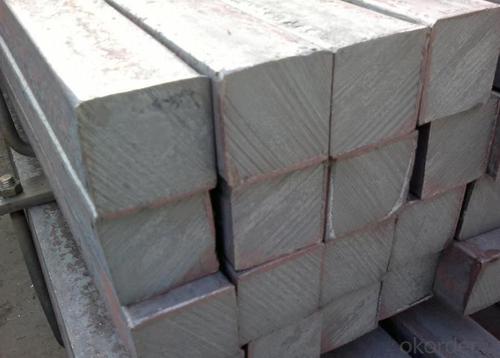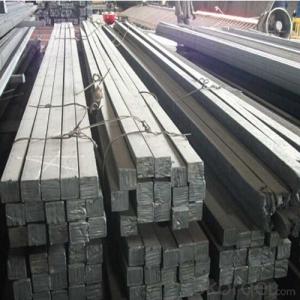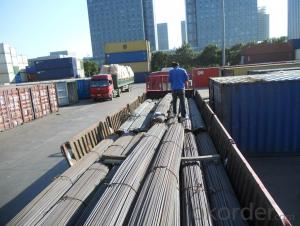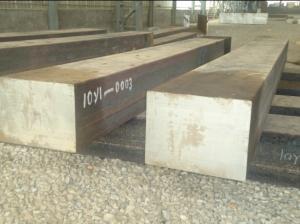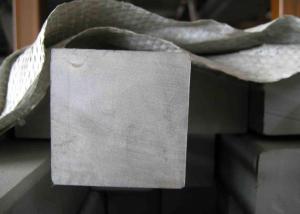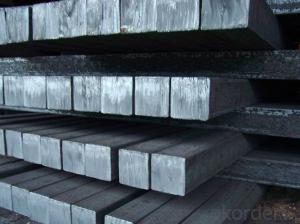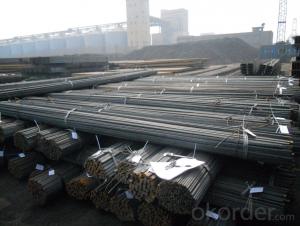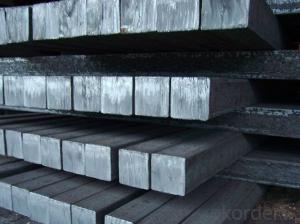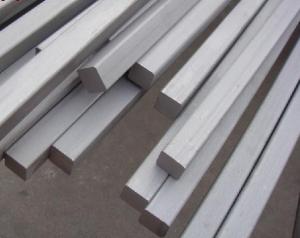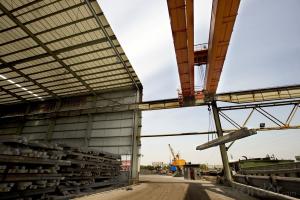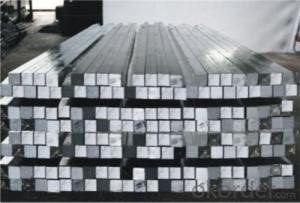HR Square Bar
- Loading Port:
- Tianjin Port
- Payment Terms:
- TT or LC
- Min Order Qty:
- 50Tons m.t.
- Supply Capability:
- 500 tons per month m.t./month
OKorder Service Pledge
OKorder Financial Service
You Might Also Like
Specifications of HR Square Bar:
-Standard: GB,
-Grade: Q195 or equivalent.
-Chemical Composition:
|
Standard |
Grade |
Element (%) | ||||
|
GB |
Q195 |
C |
Mn |
S |
P |
Si |
|
0.06~0.12 |
0.25~0.50 |
≤0.050 |
≤0.045 |
≤0.30 | ||
Measures of HR Square Bar (small measures):
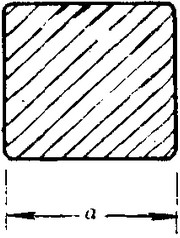
(Section of HR Square Bar)
-Length of a side and Theoretical weight of Square Bar.
|
Length of a side(mm) |
Theoretical weight(kg/m) |
Length of a side(mm) |
Theoretical weight(kg/m) |
|
7 |
0.385 |
22 |
3.80 |
|
8 |
0.502 |
24 |
4.52 |
|
9 |
0.636 |
25 |
4.91 |
|
10 |
0.785 |
26 |
5.30 |
|
11 |
0.950 |
28 |
6.15 |
|
12 |
1.13 |
30 |
7.06 |
|
13 |
1.33 |
32 |
8.04 |
|
14 |
1.54 |
34 |
9.07 |
|
15 |
1.77 |
36 |
10.17 |
|
16 |
2.01 |
38 |
11.24 |
|
17 |
2.27 |
40 |
12.56 |
|
18 |
2.54 |
42 |
13.85 |
|
19 |
2.82 |
45 |
15.90 |
|
20 |
3.14 |
48 |
18.09 |
|
21 |
3.46 |
50 |
19.63 |
Notes:
1, The theoretical weights in the list, base on the density of 7.85 g/cm3.
2, Formula for theoretical weight of Square bar: (length of a side)2 * 0.00785
3, The numbers with *mean that they are not regular or we don’t offer them.
-Regular length of Square Bar:
|
Steel |
Length of a side (mm) |
Length of steel (m) |
|
Normal steel |
< 25 |
4~10 |
|
> 25 |
3~9 | |
|
Steel of high quality |
All measure |
2~6 |
|
Tool steel >75 |
1~6 |
Usage/Applications of HR Square Bar:
-The Square Bar is normally used as structure steel.
-Row material for other structure steel like steel angles, channels, I-beams, H-beams, etc…
Packaging & Delivery of HR Square Bar:
-Packing Detail: The products can be packed in bundles by steel wires.
-Marks: We make tag marks and color marks. The tag marks with white background and red company logo will be tied up to each bundle of the products. The information is usually including basic information of products and company and other information requested by customers. As for color marks, we will paint both ends of bundles to make sure that it will be more convenient for customers to distinguish them from other products.
-Delivery Detail: 30~45 working days after receive buyer’s T.T. or L/C.
Transportation:
-The products can be delivered by bulk vessel or by container. As for container, products with the length of 6m will be loaded in 20’ container, with 9m or 12m, in 40’ container.
-The maximum quantity of loading of container is 25 tons.
-The products are usually transported to the nearest port from the production place.
Photos of HR Square Bar:
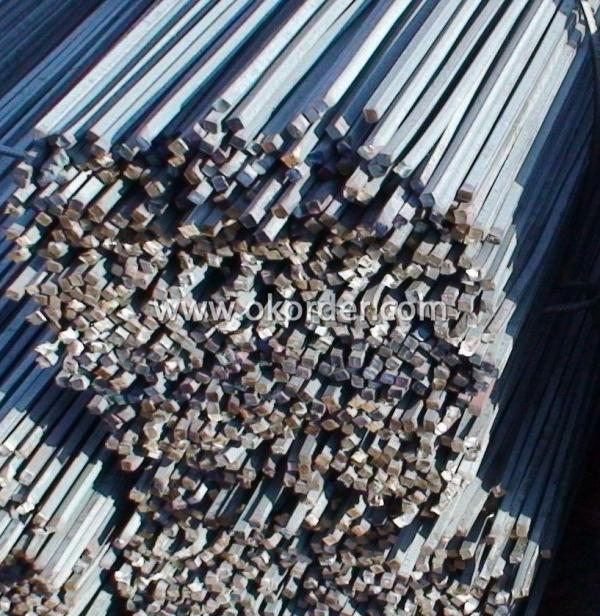
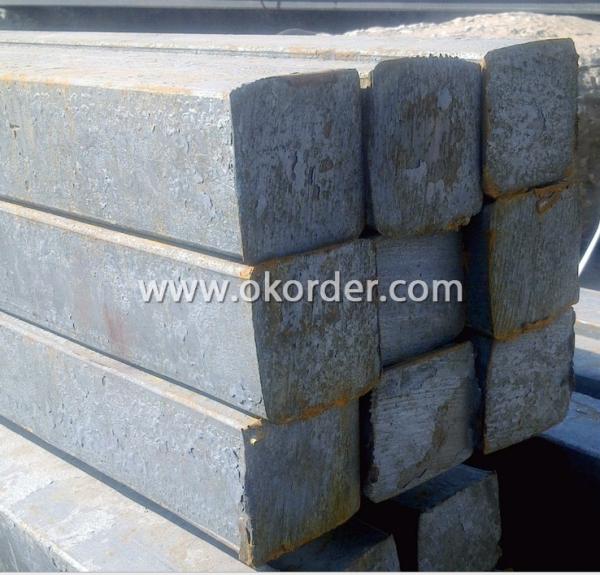
We sincerely welcome partners around the world to establish business cooperation with us on the basis of mutual trust, benefit and development.
- Q: Can a steel square be used for measuring the thickness of sheet metal?
- Indeed, the thickness of sheet metal can be measured using a steel square. Typically, a steel square possesses a slender edge or blade that can be positioned against the sheet metal to ascertain its thickness. Through comparing the sheet metal's thickness to the indications on the steel square, an approximate measurement of the sheet metal thickness can be obtained. Nevertheless, it is crucial to acknowledge that a steel square might not furnish exceedingly accurate measurements, particularly for exceedingly thin sheet metal. For more precise measurements, it is advised to employ specialized instruments such as calipers or micrometers.
- Q: Can a steel square be used for drawing straight lines?
- Drawing straight lines can be achieved using a steel square, which is also referred to as a framing square or a carpenter's square. This versatile tool, commonly employed in carpentry and various trades, comprises two arms that intersect at a right angle. The longer arm typically features markings for precise measurements and angles. To draw a straight line with a steel square, one should align the longer arm with the intended line and securely hold it in place. By utilizing a pencil or a marking tool against the edge of the longer arm, a straight line can be effortlessly created. The durability and stability of the steel construction make the steel square a trustworthy instrument for this purpose. Nevertheless, it is crucial to acknowledge that the accuracy of a straight line drawn with a steel square is contingent upon proper alignment and positioning of the tool. It is advisable to employ a level or another straight edge to validate the line's precision. Moreover, when employing the steel square, it is imperative to firmly grip and stabilize it to prevent inadvertent movements that could compromise the line's straightness.
- Q: How do you use a steel square for creating accurate half-lap joints?
- For achieving precise half-lap joints, follow these steps by utilizing a steel square: 1. Begin by measuring and marking the desired dimensions of the half-lap joint on the wooden pieces that will be joined together. It is crucial to ensure that the marks are accurate and properly aligned. 2. Place the steel square on the edge of one of the wooden pieces, aligning one of its edges with the wood's edge. It is important to hold the square firmly in its position. 3. Employ a pencil or marking knife to trace along the inner edge of the square onto the wood. This action will transfer the square's 90-degree angle onto the wood, which is essential for creating a precise half-lap joint. 4. Repeat the aforementioned tracing process on the other wooden piece that will be involved in the half-lap joint. Be certain that the marks align with those on the first piece of wood. 5. Now, utilizing a saw, carefully cut along the marked lines on both wooden pieces. It is imperative to stay as close to the marked lines as possible to guarantee a tight and accurate fit for the half-lap joint. 6. Once the cuts are completed, test-fit the two wooden pieces together. They should fit snugly, resulting in a seamless joint. If necessary, make slight adjustments using a chisel or sandpaper to achieve a flawless fit. By utilizing a steel square, one can guarantee accurately marked and cut half-lap joints, leading to strong and precise connections between the wooden pieces.
- Q: What are the different ways to hold a steel square when making angle measurements?
- There are three main ways to hold a steel square when making angle measurements: 1) Holding it against the edge of the workpiece and using the inside corner as a reference point, 2) Placing it on top of the workpiece and aligning the blade with the desired angle, and 3) Holding it against the workpiece and using the outside corner as a reference point.
- Q: Can a steel square be used for checking the squareness of a bandsaw table?
- Yes, a steel square can be used for checking the squareness of a bandsaw table. A steel square is a tool with a right angle shape, typically made of steel, and is commonly used for measuring and checking the squareness of various woodworking and metalworking tools, including bandsaw tables. To check the squareness of a bandsaw table using a steel square, you would place the square against the table's surface and ensure that it is flush against both the front and side edges. By doing so, you can visually inspect if the table is perfectly square or if there is any deviation. If the table is perfectly square, the square's edges will align perfectly with the table's edges. However, if there is a gap or overlap between the square and the table's edges, it indicates that the table is not square and adjustments may need to be made. It is important to note that while a steel square is a useful tool for checking squareness, it is always a good practice to use multiple measurement and checking methods to ensure accuracy. Additionally, following the manufacturer's instructions and guidelines for your specific bandsaw model is crucial when making any adjustments to the table's squareness.
- Q: Can a steel square be used for tile floor medallion layout?
- Yes, a steel square can be used for tile floor medallion layout. A steel square is a versatile tool that can be used for measuring angles, making straight lines, and ensuring precise tile placement. It can help in creating accurate layouts and alignments for tile floor medallions.
- Q: What are some common mistakes to avoid when reading measurements on a steel square?
- To avoid common mistakes when using a steel square to read measurements, there are a few important considerations. Firstly, it is crucial to ensure that the square is correctly positioned on the object being measured, firmly aligned against the edges for precise results. Another mistake to steer clear of is misinterpreting the markings on the steel square. These squares often feature various scales and markings, such as inches, centimeters, angles, etc. It is vital to identify and utilize the appropriate scale for the desired measurement, as using the wrong one can lead to inaccurate readings. Furthermore, reading the measurements accurately involves aligning your eyes directly with the markings. Parallax error can occur if the eye is not level with the scale, resulting in inaccurate measurements. Therefore, it is always advisable to position yourself at eye level with the markings to avoid this error. Additionally, paying attention to zero-point errors is important. Properly calibrating the square and ensuring the zero point aligns accurately with the edge of the object being measured is essential. Inaccurate alignment of the zero point can lead to incorrect measurements. Lastly, double-checking the measurements is advised to avoid any mistakes. Using a measuring tape or another tool to verify the accuracy of the readings obtained from the steel square can help identify errors or inconsistencies, ensuring greater precision. By being mindful of these common mistakes - incorrect placement, misinterpretation of markings, parallax error, zero-point errors, and lack of double-checking - one can avoid errors and achieve accurate measurements when using a steel square.
- Q: How accurate are steel squares for measuring?
- Steel squares are renowned for their exceptional accuracy when it comes to measuring angles and lengths. These precision tools are typically crafted from hardened steel, ensuring both stability and durability. When calibrated correctly and used appropriately, steel squares can deliver precise measurements for a diverse array of applications. One of the main advantages of steel squares lies in their ability to maintain accuracy over time. Unlike other materials, steel does not easily warp or deform, guaranteeing reliable and consistent measurements. This stability makes steel squares the preferred choice in numerous industries, including woodworking, metalworking, and construction. Moreover, the edges and surfaces of steel squares undergo precise machining, enabling accurate alignment and marking. The right angles formed by these squares are typically incredibly close to perfect 90-degree angles, rendering them suitable for tasks necessitating precise right angles, such as squaring up corners or assessing machinery accuracy. Nevertheless, it is important to note that the accuracy of steel squares can be affected by factors such as user error, wear and tear, or improper storage. To ensure the utmost accuracy, it is vital to handle steel squares with care and periodically check their calibration using a trustworthy reference square or angle gauge. In conclusion, steel squares are generally considered highly accurate tools for measuring angles and lengths. With their sturdy construction and precise machining, they consistently deliver dependable results. By diligently maintaining and calibrating them, steel squares can be relied upon for a wide range of measurement tasks.
- Q: What are the advantages of using a steel square over other measuring tools?
- One advantage of using a steel square over other measuring tools is its durability. Steel squares are made from sturdy materials, making them resistant to wear and tear. Additionally, steel squares provide precise measurements due to their rigid design, allowing for accurate angles and lines. Another advantage is their versatility, as steel squares can be used for a variety of tasks such as measuring, marking, and layout work. Overall, the advantages of using a steel square include durability, accuracy, and versatility, making it a reliable and essential tool for many professionals and DIY enthusiasts.
- Q: How do you use a steel square to measure diagonals?
- To use a steel square to measure diagonals, simply place the square against the corner of the object or surface you want to measure. Align one edge of the square with one side of the object and make sure the other edge is perpendicular to it. Then, measure the diagonal by extending the other edge of the square until it reaches the opposite corner. The measurement you obtain is the length of the diagonal.
1. Manufacturer Overview
| Location | Renqiu, China |
| Year Established | 1996 |
| Annual Output Value | Above US$ 30 Million |
| Main Markets | Mid East; Southeast Aisa |
| Company Certifications |
2. Manufacturer Certificates
| a) Certification Name | |
| Range | |
| Reference | |
| Validity Period |
3. Manufacturer Capability
| a) Trade Capacity | |
| Nearest Port | Tianjin; |
| Export Percentage | 20% - 30% |
| No.of Employees in Trade Department | 11-20 People |
| Language Spoken: | English; Chinese |
| b) Factory Information | |
| Factory Size: | Above 70,000 square meters |
| No. of Production Lines | 1 |
| Contract Manufacturing | OEM Service Offered |
| Product Price Range | Average |
Send your message to us
HR Square Bar
- Loading Port:
- Tianjin Port
- Payment Terms:
- TT or LC
- Min Order Qty:
- 50Tons m.t.
- Supply Capability:
- 500 tons per month m.t./month
OKorder Service Pledge
OKorder Financial Service
Similar products
Hot products
Hot Searches
Related keywords



